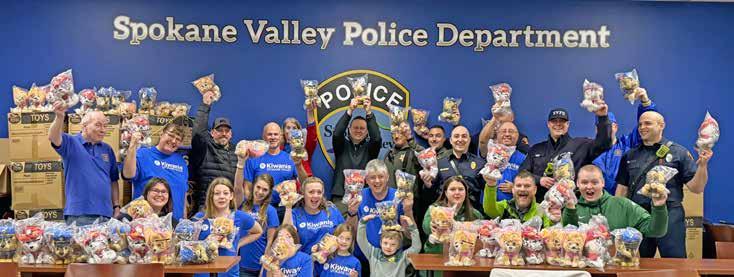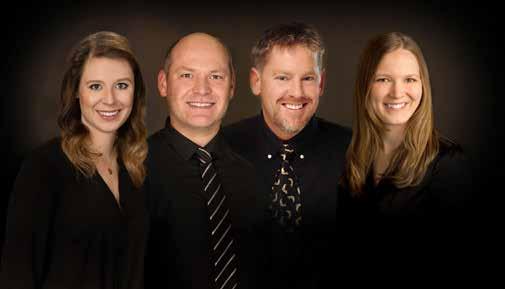
it all started in Spokane Valley, pg 10





it all started in Spokane Valley, pg 10



When he was a senior at East Valley High School, Ben Wick advanced to the state DECA competition and returned home with two unexpected first-place awards.
The state titles – one in a team category and another in an individual classification – came a surprise to Wick, especially considering the preceding regional competition had produced no blue ribbons.
Flash ahead over 20 years and Wick is on a phone call with Lance Beck, president and CEO of the Greater Spokane Valley Chamber of Commerce. Again, Wick is caught off guard by news of a recognition – this time, that he has been named the 2024 Harry E. Nelson Citizen of the Year.
“I was not expecting that,” Wick said. “I didn’t even know I was in the running. I’m super excited, appreciative and humbled. There are a lot of great leaders in our community.”
Wick joins a prestigious list of Valley leaders from a variety of fields as the latest honoree. The recognition was part of the 2024 Valley Chamber Business Awards at CenterPlace on March 27. Wick, 41, is the youngest winner in the history of the distinction, named after Nelson, an iconic Valley business pioneer and original publisher of the Spokane Valley Herald.
Following a chamber tradition of coining a phrase that capsulizes the winner, Wick will be recognized under the banner of “Commitment to Community.”
“Ben has been on the list of candidates for some time now,”
said Beck. “He’s a long-standing, committed leader who has been a stable voice and led with positive energy.”
Wick is a Spokane Valley native who graduated from EV in 2000 and went on to earn a degree in computer science from Eastern Washington University in 2004. While at EWU, he plunged into the effort to incorporate Spokane Valley, serving on the Community Action Committee with Ed Mertens. One of his first duties was to help gather enough signatures to put cityhood on the ballot. The initiative passed in May of 2002, making Spokane Valley only the third community to incorporate in Spokane County in nearly a half
century, joining Airway Heights (1955) and Liberty Lake (2001).
“It was tremendous,” said Wick, recalling the passage of the vote after four previous failed attempts.
Wick continued to serve on several transition committees after the successful vote and was among 52 hopefuls who ran for the inaugural City Council. He was part of a primary ballot that included eventual winner Rich Munson.
“I was really inspired by our first City Council,” Wick said. “I watched and learned and participated from the sidelines while I went to college.”
Wick would throw his name into the ring again during the

Ben Wick was named the 2024 Harry E. Nelson Citizen of the Year by the Greater Spokane Valley Chamber of Commerce as part of the chamber’s annual Business Awards. A graduate of East Valley High and Eastern Washington University, Wick serves on the Spokane Valley City Council and is a former mayor. He is also copublisher of the Greater Spokane Valley Current, Liberty Lake Splash and West Plains Stream with his wife Danica.
2011 council election. This time, he earned a seat at the dais.
“We’ve been so fortunate to have Ben as a leader in our city,” said Bill Gothmann, former member of the Spokane Valley City Council. “He’s a remarkable young man in terms of personality, education, intelligence and he’s very much a family man.”
Wick ran for re-election in 2015 and narrowly lost by 90 votes. Not long after the general election, he learned of a new opportunity. The publisher of two monthly publications – The Liberty Lake Splash and Greater Spokane Valley Current – was stepping away and, as of early December 2015, no one had emerged to keep the papers alive.
Ben and his wife Danica decided to tackle the challenge. The Current and Splash have been going strong ever since, telling stories that celebrate local residents and chronicle the ongoing history of two communities. Earlier this year, the Wicks added a third publication, The Stream, covering the West Plains area.
“To me, it was an opportunity to get the word out about what is happening in the community and educate and inspire people to get involved,” Wick said.
In the private sector, Wick latched on with Goodrich Aerospace after college, working there 10 years before moving onto Spokane Industries where he spent another decade, addressing duties like information systems, purchasing, shipping and receiving. He is now in a consultant role with the company as his responsibilities in publishing have grown.
Wick has won his last two council elections and previously served as mayor of Spokane Valley.
“Ben ran an outstanding council meeting,” Gothmann said. “When he was mayor, Ben gave everyone a chance to speak.”
Wick’s public sector duties




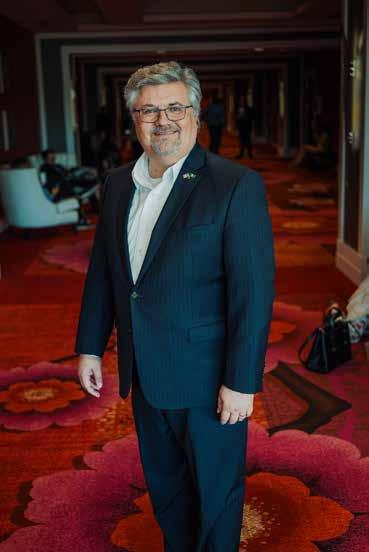












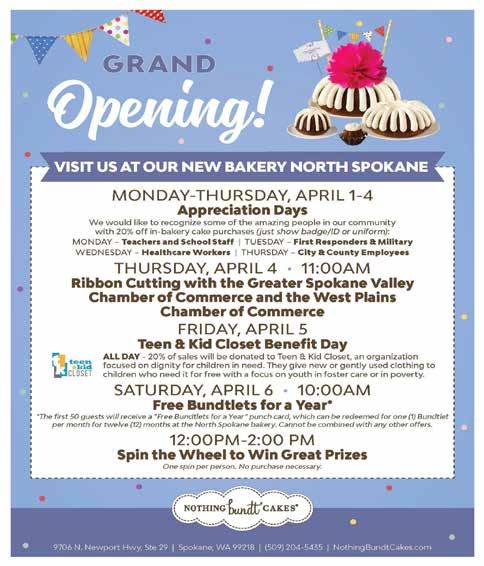
Continued from page 2
have stretched beyond Spokane Valley through service on the Washington State Freight Mobility Strategic Investment Board as city representative. His current term expires at the end of June 2026.
While Wick has developed a reputation for being an even-keeled and fair leader, he is also known as a leader of the fair – as in the Spokane County Interstate Fair. He began serving as fair ambassador in 2003 and was an assistant fair coordinator each summer he was enrolled at EWU. He was later appointed to the fair board by thenSpokane County Commissioner Mark Richard and served six years in the role, including five as chair. His tenure as the fair’s Llama Barn superintendent is now in its 12th year.
While much of Wick’s service is in the public arena, some of his efforts go on behind the scenes. Gothmann tells the story of asking Wick for ideas to help a family member with Asperger’s and Wick going out of his way to connect them with an emotional therapy program involving llamas.
“That’s just the kind of person Ben is,” Gothmann said.
Wick is now in his 13th year as a member of Spokane Valley Kiwanis, the last two as president. He also serves as a Republican Precinct Officer.
A fourth generation Spokane Valley native, Wick and his family are on the state’s official pioneer list which includes those who moved to the area before Washington became recognized as a state in the Union. His relatives have made significant contributions in areas like education, business and water utility management.
Ben and Danica have been married since 2010 and are proud parents of four children – Sabriel, 11, Hermione, 9, Celaena, 7, and Lincoln, 5.
Q: Your family roots in the Valley go way back. What sort of pride do you take in knowing you are continuing the legacy in this community as a leader and businessman that your posterity is part of?
A: I am proud of the
contributions that my family has made in our community with my grandfather starting Spokane Recycling and helping literally build our community (there is a Wick Street in the south part of the Spokane Valley), to my grandmother’s unwavering advocacy for Rockford and the military museum where she grew up and served, then down to my father’s time on the East Valley School District (EVSD) Board, my mom’s diligence volunteering at numerous EVSD PTSA and band boosters. All of these instilled a commitment to serving the community we live in. I do my best to live up to their examples, while teaching my children the importance of being involved because they are the ones that will be dealing with the aftermath of the choices that we all make today.
Q: When you were a student at East Valley High School, did you have an inkling that you would, one day, throw your hat into the government ring?
A: Not really. I didn’t run for any student government offices or anything while in high school. I was focused on playing in the band and having fun in the DECA (business) classes. In college I got involved in the student government and found that oftentimes people didn’t know how much of an impact they could have by simply getting involved.
Q: Why was it important to you to donate time toward the Spokane Valley incorporation effort, both before the successful vote in May of 2002 and afterward?
A: I got involved in the incorporation effort initially to ask the question, “Why do we say we live in Spokane, when we don’t?” and in learning more about what is possible, I started seeing the potential for what we could do as a community if we were our own city. We had, and still have, so much potential. The desire to share with others what we could accomplish kept me involved after the vote. The more I learn, the more I’ve seen how much potential we have.
Q: Has incorporation of the Valley turned out the way you expected or hoped it would?
A: Yes and no. We have made some strides in controlling our own
destiny and improving the quality of life in our community but I didn’t envision it being as tumultuous of a path as it has turned out.
Q: The Spokane County Interstate Fair has meant much more than a few weeks each September for you. What has been the most rewarding part of being on the inside of the fair in various roles over the years?
A: The fair has been a big part of my life, I met my wife at the fair, I got married at the Fair and Expo Center, I am the Llama Barn superintendent, so I would say the relationships. The fair means so much to so many and we all get together to pull it off and see each other for 10 days each year. The Spokane Valley Kiwanis Club, where I am currently serving as president, has a food booth at the fair and that booth is their primary fundraiser for the entire year. Kids across the community, including mine with their turkeys, raise animals all year long and come to show and potentially sell them at the market auction during the fair to help pay for college and their future. Numerous community members bring crafts, vegetables, blankets, paintings, flowers or any other project or activity they have worked on for months to the fair to share them with the community and get recognition. The fair brings people together to celebrate everyone’s accomplishments.
Q: Why did you and Danica decide to take a chance and become publishers of The Splash and Current in late 2015 when it seemed as if no one else was willing to step forward and keep both papers going?
A: We really wanted to help get the word out about what was going on in the community. I had recently lost my re-election campaign by 90 votes and in that year there weren’t any candidate forums, very little information about who was running in Spokane Valley and Liberty Lake and what their vision was for the community. And even though my education was stronger in math and science and Danica is a teacher by trade, we took the plunge to take on the papers so that we could share the stories about what is going on and hopefully inspire others to get involved and engaged in the community.
Q: I know you are an admirer of Abraham Lincoln and his approach to leadership. What is it about this iconic American president that you appreciate most and seek to emulate?
A: There are two traits that I think about from Lincoln. First is the value of bringing in different perspectives. Lincoln always brought in people that disagreed with him with the thought that together they would make better decisions. Second, his perseverance. When Lincoln had a goal no matter what setbacks he encountered he kept focused on it and never lost sight of the greater good. I strive to emulate both of those every day.
Q: It’s no secret that those who represent the Spokane Valley City Council have not always been on the same page in the course of your tenure around the dais. How have you tried to foster a spirit of generosity and collaboration over the years, while understanding that there will be times when leaders simply agree to disagree?
A: I relate most discord to communication issues. I try to not only share my thoughts and perspectives on topics that come before the council but also listen to what other’s perspectives are as well. You never know when you might learn something. I really hope we can get back to a place where we have more open conversations with sharing thoughts and listening to each other. Like President Lincoln, we make better decisions by listening to people with different perspectives and working together to find the best solutions.
Q: Finally, I know that you would never lobby for acknowledgement as Citizen of the Year but what does this honor mean to you?
A: I was fairly surprised. I feel like I am only doing what any one of us would have done given the same circumstances. However, it feels really good to know that others see and appreciate what I am doing to try and help make our community a better place. We can all make a difference if we get involved. “Never doubt that a small group of thoughtful, committed citizens can change the world; indeed, it’s the only thing that ever has.” Margaret Mead.
•
Liberty Lake
FAMILY DENTISTRY
509-891-5001 | 1328 N. Stanford Lane Ste 100
www.libertylakefamilydentistry.com
FAMILY DENTISTRY
509-465-5001 | 605 E. Holland Ave. Ste 108
www.northpointefamilydentistry.com
FAMILY DENTISTRY

509-455-5001 | 4100 S. Cheney-Spokane Rd. Ste B
www.latahcreekfamilydentistry.com
Maple Street
FAMILY DENTISTRY
509-928-5001 | 4610 N. Ash Ste 102
www.maplestreetfamilydentistry.com



The maps provided depict where citizens have reported Vehicle Thefts, Burglaries, Malicious Mischief and Thefts. The Spokane Valley Police Department and the Spokane County Sheriff’s office analyze this data to determine high crime areas and where to allocate resources. Citizens who have been a victim of crime are encouraged to call 911, if the crime is in progress, or Crime Check at 4562233, if not in progress, to report a crime.









Be safe with your power tools











As the weather warms and people are coaxed outside to their yards and managed landscapes, it’s time for everyone to remember how to use their outdoor power equipment safely and properly.
Avoid these eight most common mistakes when using outdoor power equipment.
1. Thinking all mowers are the same. You need to know how to handle your specific equipment correctly, and do basic operations like turning it off or on and controlling speed. Review your owner’s manual and how to use the equipment before use.
2. Not inspecting equipment before use. Always look over equipment before operating it. Check the air filter, oil level and gasoline tank. Watch for loose belts and missing or damaged parts. Replace any parts needed or take your equipment to a qualified service representative.
3. Not walking through your yard or work area before starting to mow or using other outdoor power equipment. Always walk the area you intend to work in, and look for and remove objects, sticks and other items that could create a hazard.
4. Removing or not using safety guards on the equipment. Never alter or disable safety protection measures. If needed, take equipment to a qualified service representative for repairs and inspection.
5. Using fuels not designed for equipment. Loading up your outdoor power equipment with gasoline with more than 10% ethanol in it can cause running problems and damage the fuel line. Always use E10 or less.
6. Using batteries or chargers that are not specified by the manufacturer. While a host of batteries and chargers can be found for sale online, only use batteries and chargers specified by the equipment manufacturer.
7. Not storing fuel and batteries safely. Coffee cans, milk jugs and other non-approved containers should not be used to store fuel. Only store fuel in containers designed for it, and always use up fuel before it is 30 days old. Label fuel cans with the date of purchase and ethanol content. When battery packs are not in use, keep them away from other metal objects, like paper clips, coins, keys, nails, screws or other small metal objects, that can make a connection from one terminal to another. Shorting the battery terminals together may cause burns or a fire.
8. Not cleaning or storing equipment well. Equipment will run more efficiently and last longer if it’s cleaned. Always remove dirt, oil or grass before using and storing your equipment. Store equipment in a dry place, avoiding damp or wet environments.




































Spokane Valley officials have issued a call for civility after a number of regular instances at city council meetings where members have confronted one another and the public has confronted council.
Mayor Pam Haley took the unusual step at the March 12 reading a public statement at the beginning of the meeting addressing recent confrontations between council members and with the council and public taking place at several previous meetings.
Much of the heat has been between long-time Councilman Rod Higgins and recently-elected Councilman Al Merkel, with other councilmembers such as Haley and new Councilwoman Jessica Yaeger roped into the fray. Previously reported incidents took place during a discussion on the use of social media by council on Jan. 9, the selection of Planning Commission members on Jan. 30 and most recently March 5 when the council voted 5-2 to reprimand Merkel for sharing information about a Feb. 27 executive session on the social media platform Nextdoor.
Merkel incorrectly stated that council voted to purchase land during the executive session, but later corrected that to state the vote had taken place in open session. The council felt Merkel’s decision to reveal any information about the executive session — which by law are closed to the all members of the public and not discussed openly — warranted the reprimand.
Merkel and Councilman Ben Wick voted against the reprimand.
Merkel is also under investigation into alleged misconduct with City Hall staff, with City Manager John Hohman telling council employees complained of “offensive, hostile or unwelcome interactions” with
the Councilman.
Citizens have spoken up about these conflicts during the council’s public comment session, admonishing the council for its behavior. A few citizens have also accused the council during meeting general public comment portions of dereliction of duty in taking care of city matters quickly, particularly public safety.
Haley’s statement addressed these issues, noting the list of council accomplishments over the years is “very long,” and that all councils have operated to “provide services in a unique and fiscally conservative manner.”
“Lately, too much focus has been placed on criticizing past decisions, stating nothing has been accomplished over the past several years, implying Council has not made sound decisions, or that we are not financially solid,” Haley said. “These remarks have also questioned the transparency of our operations and the efforts of our hard-working staff. We seem to have lost our focus on working as a team and the results have not been positive for our residents.”
“At last week’s meeting our community spoke up loud and clear,” Haley continued. “They demand that we work together and get back to city business. I am asking all Councilmembers, including myself, to put aside our differences and work together towards the best interests of Spokane Valley. We may have different ideas, opinions and beliefs, but we have the obligation to our residents to discuss and debate issues professionally and respectfully.”
Right of way agreements approved
The council waived its rules on multiple readings and approved a pair of franchise agreements with utility providers in the city at its March 12 meeting.
A franchise agreement is a nonexclusive contract between a city and a utility provider governing the provider’s use of
public rights of way, setting limits so the provider does not interfere with public transportation or other primary purposes. Agreements can require the provider to bear costs to relocate facilities to accommodate city projects.
The first agreement was with Wholesail Networks, LLC to renew a contract first entered into in 2013 to provide four dark fiber optic strands (two pairs) for Spokane Valley’s exclusive use. The new 10-year agreement increases the monthly charge per fiber pair per mile from $20 to $34, ensuring any costs for removing facilities from the city rights of way be borne by Wholesail and raising the level of insurance from $1 million per occurrence and $2 million aggregate to $2 million for both occurrence and aggregate.
The second franchise agreement was with Ziply Fiber, an affiliate of Wholesail Networks. Ziply is requesting a franchise of installation and maintenance of fiber optic telecommunications facilities within Spokane Valley, and received the same terms as Wholesail.
Construction beginning soon
At its March 12 meeting, council approved a $1.124 million local access street preservation services contact with Inland Asphalt. The contract will be financed with $860,000 from the city’s annual Solid Waste Road Wear Fee for the pavement preservation work and $264,000 from the Stormwater Management Fund for any stormwater system improvements within the projects.
Inland Asphalt was the lowest responsive bidder of three at $797,457, with Poe Asphalt next at $839,954 followed by Shamrock Paving at $958,079. The contract price of $1.124 million is a maximum “not to exceed” figure, with the city utilizing the unitpricing method it employed last year for the first time and with some success.
Under unit-pricing, work is assigned to the contractor by work orders for each individual location using the contract rates provided in their bids, along with determined quantities of material for each project location.
City declares land, equipment
At the March 5 meeting, council unanimously approved declaring both land and some pieces of equipment as surplus and thus offering them up for sale to the public.
The land is an almost one acre plot located at 4216 N. Best Road. The city acquired the property at public auction on Oct. 7, 2022 for $186,000 — $173,608 of which the city was awarded as part of a code enforcement action taken on the property. The balance was paid by a city cashier’s check.
The property is proposed as surplus because Spokane Valley has determined there is no need or use for the property by the city. The six vehicles are a 2004 and 2005 Dodge Dakota trucks, a Ford Taurus, a 2007 Ford E-250, a 2014 Ford Escape SE and an International 254/CC backhoe.
City regulations allow personal property such as vehicles declared as surplus to be disposed of via public auction or other means by the city manager. The city also has trade-in options.
Real property such as land “shall secure a market value appraisal” prior to public auction. According to Spokane County’s SCOUT property information website, the North Best Road property has a 2024 market assessed value total of $166,210.
City Finance Director Chelsie Taylor said the city has a contract with auction company J. Stout, and citizens wishing to bid on these items can contact them to find out the date and time of upcoming auctions. Items not auctioned can be disposed as scrap.
“I don’t anticipate that to be the case for these items,” Taylor said. “I do believe they will be sold at auction or traded in.”
“Do we have an estimate value on these things right now?” Councilman Al Merkel asked.
“I do not,” Taylor replied.
In response to another Merkel question, Taylor said the trucks were used by city inspection staff in the field and therefore have a lot of miles and wear and tear. The backhoe was used at maintenance shop.
Current news sources
Spokane Valley Fire Department (SVFD) crews responded to a total of 1,843 emergency incidents for February 2024.
There were no firefighter injuries, and the cause of the fire is under investigation.
February 16
Spokane Valley Fire Department (SVFD) is honored to announce that we have been selected as the winner of the 2024 Randy R. Bruegman Agency Innovation Award from the Center for Public Safety Excellence.
The award is presented to an agency that has embraced continuous improvement, is focused on outcomes, embodies progressive leadership, and has worked collaboratively within their agency and community to innovate a practice leading to improved outcomes that could serve as a model for the greater fire and emergency service.
February 14
Members of the Spokane Valley Fire Department (SVFD) and the City of Spokane Fire Department acted swiftly Valentine’s night to extinguish a fire that consumed a large portion of a single wide trailer home in the Spokane Valley near the 5800 block of East 4th Ave. The fire was extinguished within 15 minutes of the first engine’s arrival.
Prior to their arrival on scene, VE6 observed a large smoke column. VE6 arrived on scene first and immediately stretched a hose line, getting water quickly on the fire. The occupants were already out of the trailer home prior to the first unit’s arrival. Automatic Aid (and Valley units being on other calls) resulted in multiple units from the City of Spokane fire department filling out the rest of the fire response. Units involved included VE6, V21, V22 and V31 from the Spokane Valley Fire Department as well as SE14, SE8, SE1, SE7, Quint 11 and SL1 from the City of Spokane Fire Department.
During every structure fire, a standardized series of events occur including, rapidly extinguishing the known fire, checking the structure for fire extension into hidden areas, a rapid primary search of the entire building (or trailer) for occupants, and a more thorough secondary search of the entire building for occupants. Other actions can include removing or covering valuables that could be damaged during suppression activities, as well as removing debris resulting from the fire. These events can occur more quickly when there are more units on scene, early in the fire operation.
Four residents (two adults and two children) were displaced from the trailer home with Red Cross arriving to provide assistance. Two dogs were inside during the fire and though they were removed from the trailer home as quickly as possible, they were not able to be resuscitated. American Medical Response (AMR) evaluated one of the adult occupants.
The recipient of the 2024 Randy R. Bruegman Agency Innovation Award is the Spokane Valley Fire Department (SVFD) which successfully executed two innovative fire levy campaigns within six months, using data analytics and community engagement to secure crucial funding. Leveraging geographic and demographic data, SVFD strategically focused on neighborhoods with the highest service usage and employed a multichannel social media campaign, including infographics, videos, and town hall meetings, to inform and engage the community.
The introduction of a “levy calculator” provided transparency on the personal impact of a “yes” vote on residents’ taxes, fostering accountability. The outcomes included successful passage of the levy, enhanced community support, maintained response times, upgraded equipment and training, increased transparency, and improved safety awareness, aligning with SVFD’s strategic goals. The design, development, and implementation involved a wellstructured process, with collaboration across departments, a dedicated campaign team, technology integration, and transparent communication. To replicate the innovation, agencies are advised to focus on needs assessment, goal setting, stakeholder engagement, strategic planning, technology integration, communication materials, community engagement, transparency measures, collaborations, and voting drives, as outlined by SVFD’s comprehensive strategy.
“This prestigious recognition is a testament to the hard work, dedication, and innovative spirit of every member of our fire department. We are immensely proud of the commitment to excellence that our team has demonstrated. The Randy R. Bruegman Agency Innovation Award acknowledges our relentless pursuit of innovative practices in ensuring the safety and well-being of our community. This achievement would not have been possible without the support of our community, partners, and the incredible efforts of each member of the Spokane Valley Fire Department. We look forward to continuing our mission of service, safety, and innovation. Thank you for being an integral part of our journey.” - Chief Frank Soto Jr. Spokane Valley Fire Department
For more information on the award and the Center for Public Safety Excellence go to: www.cpse.org.




The 116th Air Refueling Squadron of the Washington Air National Guard got its start in Spokane 100 years ago and since then multiple generations of the same families have called the unit home and flown or fixed its airplanes.
The unit actually got its start even earlier, in 1920, when the aviation committee of the Spokane Chamber of Commerce to talk about the possibility of getting an Air National Guard unit in the city. Enthusiasm was strong and early supporters convinced the city of Spokane to lease them the old Parkwater Municipal Golf Course to create an airfield that would later become Felts Field.
In 1924 word came that there
would be one Air National Guard Unit in Washington State, and whichever city could raise $10,000 first would get it. Weeks of frantic effort followed. The Spokane Chamber of Commerce raised $5,000, the Spokane County Commissioners contributed $2,500 and the Spokane City Council gave $2,500. Spokane had beat out Seattle and Tacoma for the rights to the first Air National Guard unit in Washington State.
“The city and the folks who wanted it fought tooth and nail,” said Major Brit Quigley, a pilot in the 116th for the last 25 years.
On August 6, 1924, the 116th Observation Squadron was created. Historically, however, the unit was a reorganization of the 116th Aero Squadron, which was created in 1917 and began serving in France later that year. It, in turn, was redesignated the 637th Aero Squadron (Supply) in early 1918. The unit remained there until the end of World War I in November 1918.
The first commander of the 116th was retired Army veteran and wheat farmer John T. Fancher, who had served as a pilot and air combat unit commander in World War I. He had been actively involved in the creation
of the 116th and soon set about creating the unit from scratch.
Stories have been told about the first airplanes that would arrive in Spokane, three Curtis JN6-A2 “Jennys.” They came by train in giant boxes and had to be assembled, Quigley said. “They didn’t have oil and they went around the city getting samples of oil,” he said.
They also didn’t have gas, and one of the unit members used his own money to buy 15 gallons of gas, Quigley said.
Current members of the 116th appreciate the unit’s early history. “That grit and that determination in that story is what makes Spokane so special,” said Major Brian Kranches.
“The people who started that were a special breed,” said Quigley.
Graphic artist Steve Grime was a pilot in the 116th before he retired in 2016. He went to Eastern Washington University to earn a degree in graphic design after he retired. His former unit commanders, knowing that, reached out to him to see if he was willing to design a special logo and other items for the unit’s 100th anniversary. He was happy to do so. “You only get a centennial once,” he said.
One of the things he designed was art for the tail of the giant KC135 tankers that he used to fly. He was inspired by designs used on the unit’s planes in the 1930’s. “Spokane aircraft, specifically at Felts Field, had that kind of design.”
The design includes solid vertical swaths of yellow and black paint as well as a section with red and white stripes. “100 Years of Flight” is emblazoned on the tip of the tail. Also featured prominently is the unit’s insignia, an Ace of Spades playing card with a dagger thrust through the middle. The tail design is on only one plane.
“They had to go through serious bureaucratic hurdles just to get it painted on an airplane,” he said.
There is, of course, a story about the creation of the unit insignia. As the story goes, members of the unit were having a late night poker game in 1931 when the topic of an insignia came up. Lt. Laurie Heral tossed an ace of spades on the table and said it was known as the “death card.” Everyone liked the idea of using the ace of spades, but Heral thought it was missing something. He took

out a dagger and impaled the card through the center, suggesting that the dagger gave it more impact. That was the birth of the “ace and dagger” unit insignia that is still in use today.
Grime also designed a poster, stamp and a logo that can be put on t-shirts and coins. “They’ll have swag to sell at airshows,” he said.
Grime served for 27 years, spending the last 10 as a tanker pilot in the 116th. Prior to that he was a helicopter pilot in a rescue unit. “It’s like going from a Ferrari to a Mack truck,” he said of the differences between the two types of aircraft. “It’s a large aircraft and it’s not as nimble as a helicopter.”
He said he is pleased to be a part of the unit’s 100th anniversary celebration. “A rich history of Spokane runs through that unit,” he said. “It was a good unit. We certainly traveled the world, to some great parts and not so great parts.”
Major Jon Cael is a fourthgeneration member of the 116th. His great-grandfather was the first to serve and he grew up hearing stories from his grandfather and how happy he was to be part of the unit. As a child, he would accompany his father when he had drill weekends and play football with other kids who came along.
Being a member of the Air National Guard was something he was steeped in. “I just remember back to my dad going off to Desert Storm,” Cael said.
Like his father, grandfather and great-grandfather before him, Cael got his start in aircraft maintenance. But he is the only member of the family to move on to become a pilot. He wanted to serve in the Air National Guard instead of the Air Force because he had no interest in being transferred to a new posting every few years.
“I wanted to be home,” he said. “I wanted Spokane to be home. I have a lot of roots here.”
His father is now retired, but the two did get an opportunity to deploy together before that. “It was cool,” Cael said. “Being able to work with him on the flight line and having him launch me out was so cool.”
Staff Sergeant Damen Gaddis is a boom operator and has been with the 116th for six years. He’s a secondgeneration member of the unit and his father still serves in the unit. “I enlisted in the Guard when I was 17 years old,” he said.

As the years went by and planes changed, so did the mission of the 116th. During World War II the unit did submarine patrols along the west coast for a time. It was known as the 116th Fighter Squadron when activated during the Korean War. In the late 1950’s it became a fighter interceptor squadron. When the KC135 Stratotankers arrived in 1976, the unit moved from Geiger field, where it had been since the late 1940s, to Fairchild Air Force Base.
The 116th squadron is part of the 141st Air Refueling Wing, commanded by Col. James McGovern. The wing used to be classified as a “ready reserve” unit, which was only to be activated in cases of high need, McGovern said. It’s now classified as an operational wing.
“Now we’re just like the active duty, but a large portion of our unit is part-time,” McGovern said. “We fly every day. We refuel all the conventional aircraft.”
As a National Guard unit, the 116th has a dual mission, McGovern said, Federal and domestic. Most of what they do is considered federal, refueling aircraft wherever and whenever needed. In domestic operations, they can assist states with their needs.
As an example, McGovern points to the National Guard response to the January 6, 2021 riot in Washington, D.C. The 116th not only supplied fuel to planes transporting Army National Guard troops to D.C., they flew some of the troops themselves. In total, pilots from the 116th flew 37 flights. “The numbers were just astounding,” McGovern said. “We
stand in the ready to help the states.”
It’s not unusual for members of the 116th and 141st to be deployed around the world. There are currently a little more than 100 members deployed and once they return in April, another hundred will take their place, McGovern said.
He said he’s impressed by the skill and dedication shown by members of his air wing, most of whom have day jobs. “These are airline pilots, electricians,” he said. “We used to have a school teacher.”
It’s not unusual for members of the 116th to spend decades in the unit before retiring. They see themselves as a family, forming bonds strengthened because they aren’t constantly transferring to the next post.
“It’s the Guard family,” Quiqley
said. “It’s kind of embedded in our culture. We all band together and take care of each other in good times and bad.”
The Guard family will have more chances to celebrate the unit’s 100-year history, including during a special picnic held during the August drill weekend, McGovern said. Former and current members of the unit will also be invited to a gala on August 9.
“We’re one of 12 flying units in the country to reach their centennial,” McGovern said. “It’s a pretty big deal for the airmen.”
In the meantime, residents can keep a lookout for the KC-135 with the special tail art in the sky over the West Plains. “That plane is what we consider our flagship,” McGovern said. “That’s the one we can actually have nose art on. It’s our baby.”
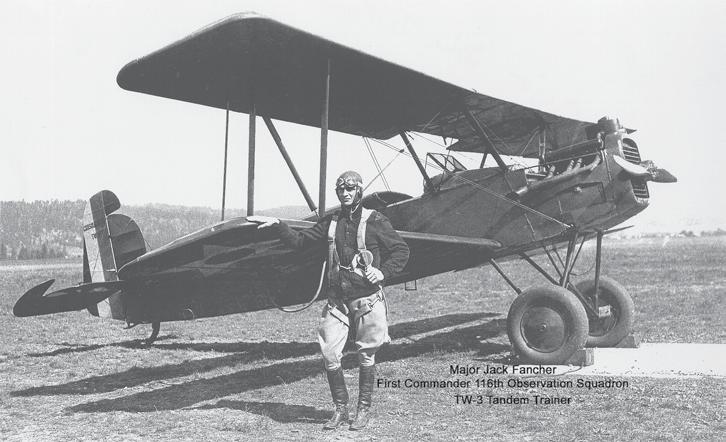

As a student, athlete and volunteer, Isabella Clark has made an impact at Valley Christian School. The senior maintains a 4.0 grade point average and is treasurer of the VCS National Honor Society chapter. She is a four-year letter-winner in volleyball and, as a sophomore, was part of an award recognizing the Panthers’ squad for achieving the highest GPA among state 1B/2B high schools. She also participates in track. Clark has contributed to a variety of community service efforts, known as “Panther Projects” including cleaning efforts at the Union Gospel Mission camp. She also volunteers at Mission Church in Spokane Valley, teaching and mentoring kids. She was part of the Valleyfest Royalty Court as a princess two years ago. She has been nominated as a Spokane Scholar in Social Studies. Clark will begin studies at Grand Canyon University in the fall.


Valley Christian senior Simon Hill has given Panther Nation plenty to cheer about as a standout competitor in cross country, basketball and track. He has lettered three years in cross country and earned the Mighty in Spirit award as a junior. In basketball, Hill was captain for two years and lettered three years. He has also been a captain for track, competing in the 100, 200 and 400-yard runs as well as the javelin. He was part of a 4 x 400 relay team that advanced to state in 2022. He has a personal best in the 200 of 26.5 seconds and 55.6 in the 400. Hill is ASB president and part of Worship Team. He has also contributed to a variety of community service projects. Hill plans to study theology and earn his Master’s in Divinity at Grand Canyon University.

Cammy Presho is a former banker who helped launch Greater Good Northwest (GGNW) with a mission to “amplify awareness of the needs of the community and facilitate collaborative impact for the greater good.” The Spokane Valley resident now volunteers with GGNW as an advocate for nonprofits and people interested in starting their own cause. She currently works as operations manager for Champion Career Services and is involved in the company’s philanthropic arm, Champion Generosity. Presho has served with the YWCA’s Hope and Power program, helping fellow survivors of domestic violence learn financial literacy. She was named a YWCA Woman of Achievement for Community Involvement in 2012. She also served on the committee for Bank On helping residents without access to a traditional checking account establish a banking history. Presho and her husband Josh have three kids in their blended family.


On Monday March 18th at West Valley High School, a Geometry and Leadership teacher was surprised with awards.
Little did Shante Payne know that the live taping of her students' leadership project, Eagle News, had a profound surprise in store for her. Unbeknownst to her, the event was going to receive extensive coverage from local news stations, leading to her being recognized and honored with prestigious awards.
As a member of the Eagle News team, along with his peers Abby Hogberg and Derek Maney, West Valley senior Preston Engeland nominated Shante Payne for the Northeast Region's Regional Middle-Level Activity Adviser of the Year award.
“I nominated Ms. Payne because she receives very little recognition and does so much for West Valley High School. She works to include all students and members of our community as she understands and appreciates new perspectives and knows that all voices deserve to be heard” says Engeland.
Originally from Albuquerque, New Mexico, Payne's upbringing was not without its share of challenges and obstacles. It was through these difficult experiences that she cultivated the invaluable traits of resilience, perseverance, and empathy. These qualities have since formed the foundation of her educational viewpoint and approach.
“Ms. Payne allows her classroom to be a space where student leaders can thrive and grow,” Engeland explains about Payne’s classroom. “She preaches individuality and lets student leaders practice their skills.
Payne believes in allowing students to learn by doing so
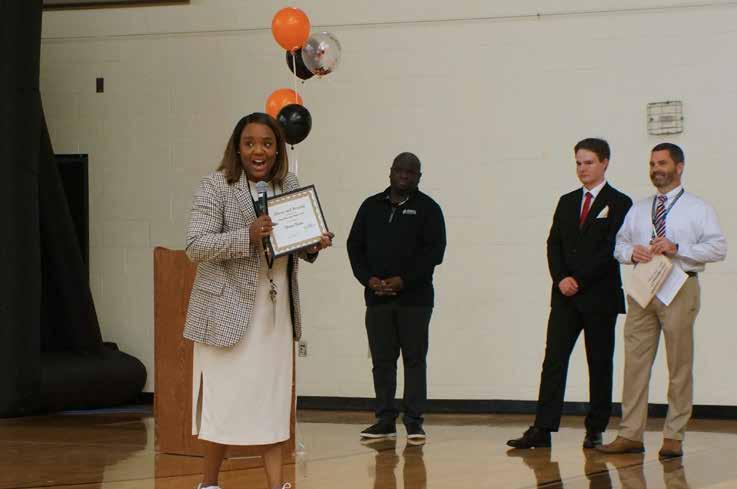
that they build confidence in their abilities. “I always tell my kids for every action, there's a reaction, right? For every action, there's a consequence, whether that's a good or bad. I don't think there's enough people in the world teaching this age group that.”
Her self-acclaimed “tough love” teaching style is proof that students can rise to meet goals and expectations if given support. When referring to the two students who nominated her for the awards she says, “I always joke with them, they should actually be the teacher and I shouldn't because they do a lot more than I do.”
At the start of the school year last fall, Engeland, Maney, and Hogberg approached Payne with the idea of starting a weekly news program for the school. “We showcase many different students and staff and share what’s going on in our community on the morning news.” Engeland explains that between the three of the they interview, record, and edit the show. Payne has helped by guiding and offering
support, but let the team make the decisions.
Payne’s passion is helping teach and encourage children both inside the school and outside. She taught at the juvenile detention center during the summer last year and plans on continuing it again this summer. She believes in all children, “I always have known that I wanted to work with populations of kids who are kind of overlooked, I guess that's the best way to say it. Our juvenile delinquents and juveniles in the system, whether that's the foster care system, or the court system.”
The excitement for Payne continued when West Valley Superintendent Kyle Rydell took the podium after the Eagle News broadcast to announce that Payne was being recognized for the West Valley Above and Beyond award. The tradition began over 8 years ago to acknowledge and honor staff and community members who have gone “Above and Beyond”.
“Shante is a great example of a staff member who has gone
above and beyond her normal duties. She has taken on multiple leadership roles to support the leadership students as well as helping build a positive culture at WVHS.” Rydell shares about Payne and her attributes.
Nominees are recommended to the school board by anyone and chosen at the school board meeting. “She was nominated by our WVSD student board representative Derek Maney which makes this even a more special recognition,” Rydell explains.
Payne continues to foster a sense of belonging and being heard in her classes. Her passion for helping students succeed is recognizable after a brief interaction with her. “I love the fact that they let me show up every day and be me. It’s really rewarding. I just love them all and I appreciate what they’ve done for me because believe it or not, I’ve done so much growing in the last two years too. I see them, I hear them, I love them, and without them, I really am nothing.”
In the heart of Spokane Valley, a sizzling sensation has taken the culinary scene by storm with the grand opening of a new Killer Burger location. This arrival promises more than just a delectable dining experience; it brings a unique blend of quality ingredients, innovation, and community spirit to the area. As locals eagerly line up to sink their teeth into these mouthwatering creations, the Killer Burger franchise is poised to become a cherished member of the Spokane Valley community.
Wes Walter is the local franchise owner of Killer Burger and unbeknownst to him, he had the unique opportunity to experience the burgers prior to the creation of
what is know today as Killer Burger. Wes has a degree in Music and a passion for directing choirs. He called Portland, Oregon home and was on a flight back home after a work trip had taken him to San Diego when Wes struck up a friendly conversation with the man sitting in the same row as himself. During the conversation, the man shared how he was returning from a church mission trip and was going to be taking up a congregation in Gresham, Oregon. He proceeded to ask Wes to come and be the music leader at the church with him. When the flight landed two hours later, Wes had agreed to the position and unbeknownst to him, changed the direction of his future.
Nine months later, the man named TJ, who was the senior pastor at the church, invited Wes and his family over for dinner. “He said ‘Wes do you like burgers?’, so I said ‘Yeah of course!’ and he says ‘Well come over hungry!’ So we showed up for dinner a few days later and I could smell the bacon from outside and I walk into the house,” Wes reminisces about the first time trying
the unique burgers. “The kitchen is a disaster! It looks like he’s been creating things all day. That day we were introduced to nine signature burgers that he had created and that he didn’t know at the time, but that he would end up leaving the ministry and going into restaurants to open a burger joint. He ended up naming it Killer Burger.”
After years of enjoying each bite of the unique burgers, Wes went to TJ, owner and creator of Killer Burger and asked to be the first franchise owner. He was given the opportunity to open a location in Happy Valley, Oregon in 2013 and had overwhelming success.
During the Covid Pandemic, Wes and his family made the decision to sell their Happy Valley Killer Burger and move back home to where he grew up in Coeur d’Alene.
It was shortly after moving home to the Inland Northwest that Wes realized the need for a different and new approach to the burger scene. He opened the first Killer Burger in the area in Hayden in late 2021. The success of Killer Burger led to Wes looking for other locations in the area.

Wes attends a local Spokane Valley Church and explains how the new Valley location came to be, “I Kept seeing this Sweeto Burrito sign as I’d come around the corner of Broadway and Sullivan. It’s a large sign and I just thought wouldn’t it be fun if that was a Killer Burger? My wife said let’s do and try to make it a Killer Burger!”
Once Wes secured the lease, he had five weeks to build out the location and open for a soft opening on November 8th, with their grand opening on November 15th. During their soft opening, Wes ran a special for $10 that included a burger and fries with $5 of each purchase going to the local Make-A-Wish foundation. Wes recently presented them with a check for $13,190! On the day of their grand opening, Killer Burger sold 2,100 burgers.
“When I moved here, I kept seeing people ask where a good burger was,” Wes explains about his decision to open a location in Spokane Valley, “But nothing quite like a Killer Burger was here. Where it’s just burgers, fries, beer, and Coke products done in a highquality way.”
The menu at Killer Burger is a testament to culinary innovation, offering a diverse selection of signature creations that cater to a wide range of tastes. Whether you're a traditionalist who craves the classic American cheeseburger or an adventurous foodie in pursuit of bold flavor combinations, Killer Burger has something for everyone. Killer Burger sets itself apart by ensuring a superior taste with an emphasis on quality.
Their menu includes tastes that you’d typically not expect on a burger. Take the Peanut Butter Pickle Bacon burger that includes bacon, peanut butter sauce, house sauce, mayo, grilled onion, pickles layered onto a slow smashed and grilled fresh grass-fed beef patty that’s been rested on a locally made bun. It creates an experience that won’t soon be forgotten.
For those looking for a lighter option, Killer Burger offers a smaller ‘Pint Size’ burger patty and chicken options.
Online ordering can be made through the website at Killerburger. com. Killer Burger is opened seven days a week from 10am to 9pm for dinner in and take out.



DISTRICT
For kids ages 5+ and their families
Make a mini light saber, build a fighter ship, and try other crafts and activities.
Dress up as your favorite Star Wars character.
ARGONNE LIBRARY
4322 N Argonne Rd
Saturday, April 27, 3–4pm
SPOKANE VALLEY LIBRARY
22 N Herald Rd
Saturday, May 4, 3–4pm
OTIS ORCHARDS LIBRARY
22324 E Wellesley Ave
Thursday, May 9, 4–5pm
The family of Winona Duncan gathered to celebrate an extraordinary milestone: reaching the remarkable age of 100 years. In a world where the passage of time can often feel fleeting and intangible, reaching a century is not just a measure of days gone by, but a testament to the resilience, wisdom, and boundless spirit of a life lived with determination.
Duncan, whose maiden name is Craig, was in the middle order of her nine siblings. She had four older siblings: Sam, Louisa, Ernie, Ruth and four younger siblings: Margarett, Paul, Betty, and Lee. Her parents, Roy and Alma Craig had children spanning over 25 years and moved numerous times across the Midwest. Duncan was born in Winona, Kansas just days after the death of the 28th President of the United States, Woodrow Wilson.
While the family resided in Kansas during her very young life, their house burnt down on their farm and all the family’s possessions were lost. Her parents made the decision to move to Castle Rock, Colorado and began building a home for her and the older siblings. After several years living in Castle Rock, her family welcomed the four youngest children.
Growing up during the Great Depression in the Midwest proved a different lifestyle than what younger generations would be accustomed to. “My mom tells stories about the kids all riding together to school on a great big horse!” Sherrie Potter recalls conversations with her mom over the years. “One of the things that she would laughingly share was that their outhouse was a four-seater where they would all sit together and talk and tell jokes! My mom also talks about the fun she had at the country dances, and even as recently as her 100th birthday said, ‘It was a really nice time, but I wish there would have been dancing!’ Dancing was a favorite past-time of my mom and dad while I was growing up.”
Unfortunately, her father passed away in his mid-forties when Duncan was just 16 years old, and Duncan dropped out of high school and entered
the workforce to help take care of her younger siblings, since her older siblings were either serving in World War II or had started their own families. Duncan did what she could by working in a truck-stop as a waitress for a few years.
Shortly after turning 18, she met Robert Duncan (Bob), began a courtship, and married him in the fall of 1942. They were married by Bob’s mother, Cora Rose-Duncan, a Pentecostal pastor, in her front room in Shannon Springs, Kansas. The bride’s mother and a sister made the trip to witness the heartfelt event.
A few months after being married, “Bob came home with a little package wrapped up. He said he had bought a present for his mother. I was so mad! So, I grabbed it and threw it in our small fire. Bob got it quickly out of the fire and said ‘What are you doing! That’s for you!’ and handed it to me. They were my first pair of earrings. Gold clovers with an emerald in the middle. I had to go get my ears pierced. I was so proud!” Duncan recalls the beginning of her marriage.
After a year of marriage, the newlyweds moved to an unnamed location in Louisiana and Bob got a job working for an oil company surveying the swamps and coastal areas. “We’d go fishing every weekend and just cook it and eat it fresh.” Duncan shares about
how she came to enjoy fishing, since it wasn’t something that she had had the opportunity to do while growing up on a farm in the Midwest. “While I lived in Louisiana, ladies taught me how to crochet and knit. I still enjoy doing that.”
During the years they were in Louisiana, Bob’s family moved to Valley Ford, Washington and in 1950, the Duncan’s packed up their meager possessions and made the lengthy journey to Valley Ford, Washington. “His family had sent us a message saying there was a lot of work going on up here. So, we packed up everything in a small trailer and moved. My kitty was the most important thing I cared about. She sat on my lap the whole way,” Ducan reminisces about making the move up to the Pacific Northwest.
After they arrived in Valley Ford, they lived with their in-laws for three years. Later, in 1953, they found a permanent residence in Greenacres, Washington, where they welcomed their first child, Franklin. The family continued to live in the home in Greenacres and were blessed with the addition of Robbin, Sherrie, and K. Bruce. During this period, Bob started working at the Trentwood Kaiser Aluminum Plant, where he remained employed until his retirement in the late 1980s.
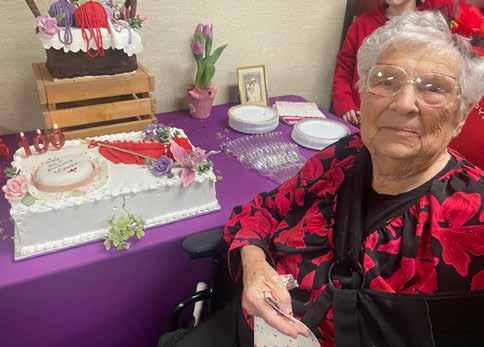

In the fall of 1960, the Duncan’s bought 200 acres in the lush and beautiful Foothills of Mount Spokane. Sherrie recalls from her childhood on the farm, “We had horses, cows, pigs, chickens, turkeys, and we would even catch chipmunks during the summer. Us kids always had a lot of fun, we were always outside! We had a pond that we would skate on in the winter and then swim in during the hot summers. I look back on my childhood fondly. My mother thoroughly enjoyed the years of us kids growing up on the farm. There was never a dull moment!”
“I loved living out in the Foothills,” Duncan describes fondly, “I enjoyed raising my kids on the farm.”
With the health of Bob declining in 1994, the Duncans sold the farm, moved to Spokane Valley and built a new home. Bob passed away in 1998 and a few years, Duncan sold the home and moved into an apartment.
The subsequent years saw Duncan move to various locations throughout Spokane Valley. Her health has continued to surprise doctors and she is “as spry as a spring chicken”, becoming a centenarian was a significant milestone that Duncan eagerly anticipated.
“My fondest tradition with my mom was that for my birthday we would always go to lunch. And then once I had my daughter, Ashley, we would go for hers too. My mom and dad used to always go camping. And once my dad passed, my mom who was in her 70’s up till in her 90’s would still join us camping, out fishing, and up picking huckleberries in our secret spot!” Potter shares.
“My grandma was watching my brother and sister and I while my older sister went on her senior trip in Europe,” Granddaughter Kay Potter shares her favorite memory of Duncan, “and we were all outside enjoying the summer evening when suddenly, we heard a loud pop! When we went inside, we realized she put eggs on the stove to boil and it overcooked and exploded! It was all over the stove and the wall behind it! Everywhere! She just laughed it off, we all laughed!”
On February 7, 2024, the family hosted a wonderful celebration to honor Duncan. It was an epic 100th birthday party with attendees spanning generations and states. But the celebration was not just an event; it was a time to share and connect with loved ones through shared stories, laughter, and memories of Duncan’s journey through time.









 By Craig Howard
Current contributing editor
By Craig Howard
Current contributing editor




When the Brooklyn Dodgers announced in 1958 they were leaving their longtime home in a borough of New York City to relocate to Los Angeles, news of the move reverberated to the Inland Northwest.
The transition, along with the uprooting of the New York Giants to San Francisco the same year, would alter the tectonics of Major League Baseball and signal a new era of franchises setting up shop in cities west of the Mississippi. For the Dodgers, it meant a shift for their Pacific Coast League team, the Los Angeles Angels, and the launch of a new minor league affiliate – the Spokane Indians.
Even though the Spokane Indians’ history goes back to the inaugural season of 1903 in the Pacific National League, the collaboration with the Dodgers meant expanded opportunities and a brand new stadium on the western fringe of Spokane Valley. Built on the Interstate Fairgrounds, the venue was ready in time for the first pitch of the 1958 campaign.
The first run at Avista Stadium was scored by Maury Wills who would go on to become National League MVP for the Dodgers in 1962 when he stole 102 bases to set a new single-season record. A few relics from the Dodgers’ days in Brooklyn made it all the way across the country to Spokane, including the batting cage where iconic players like Jackie Robinson, Gil Hodges, Roy Campanella and Duke Snider once honed their skills at the plate.
Otto Klein, senior vice president of the Indians, hasn’t been around since the opening of Avista Stadium, although the longest tenured employee of the team can tell you much of the history. As the 2024 season dawns, Klein is bubbling with enthusiasm over what he calls “the biggest overhaul the stadium has ever had.”










By the time the Indians’ home venue hosts the season opener on April 5, renovated clubhouses and stadium lights will be ready. A towering new neon sign is already in place outside the stadium on Havana in the city of Spokane Valley.
“They’re going to be spectacular,” Klein said of the lighting improvements. “Not only will there be better lighting on the field, the lights can change colors. We can make the lights dance.”
This summer, indoor batting cages and fitness areas will be added along with dining areas for players behind the clubhouses. The second phase will include new outfield fencing and a complete replacement of the field turf, which will remain natural grass. A mammoth video board, 30 feet tall by 70 feet wide, will eventually adorn a space about the left field fence.
“We’re going big-time with all these improvements for all users of the park,” Klein said.
Also in the works is a shift of the Indians’ dugout from the first base line to the third base line, a configuration that hasn’t happened in 60 years.
Split between two phases, the advancements at Avista Stadium carry a price tag of $16.5 million. Spokane County, the state of Washington, Avista and the Indians are all part of the funding mechanism. Major
League Baseball (MLB) is requiring all 120 teams in Minor League Baseball (MiLB) with major league affiliations to meet required improvements to their home venues by 2025.
Klein said another transition –the move in 2021 from short-season Single-A to a High-A campaign that runs from April 5 to Sept. 8 – has changed the culture of minor league baseball in Spokane. The team has set all-time attendance records the last two seasons, drawing 249,000 fans last year.
“The response from the community has been incredible,” Klein said.
Recipient of the 2023 MiLB CommUNITY award, the Indians will be adding features like “Copa la Diversion” to this year’s schedule. Billed as an effort “to embrace the culture and values that resonate with U.S. Hispanic communities that field MiLB teams,” the campaign will feature the Indians wearing Latin-influenced uniforms on May 5 (Cinco de Mayo), July 14 and Aug. 18. Special promotions, food offerings and entertainment will also tie into the theme.
On the diamond, Robinson Cancel is returning for his second year as Indians’ manager after a 62-67 season in 2023 that included the typical shifting of star players up the ladder within the Colorado Rockies’ system.

“Hopefully, we’ll have a better season,” said Cancel who is in his eighth year with the Rockies’ organization. “I didn’t think we had a bad season last year but I feel like we can do better. We’re going to be aggressive on the bases and put the ball in play.”
Cancel played parts of four MLB seasons with Milwaukee, the New York Mets and Houston before retiring as a player in 2011. As he leads players beginning their respective pro baseball journeys with a goal of reaching the majors, Cancel said he doesn’t get caught up in his own experience.
“I don’t talk about myself,” he said. “I do talk about what it takes to get to the big leagues. It’s not easy to get there and stick there.”
With a roster full of players with diverse backgrounds, Cancel says he focuses on growing a culture that emphasizes teamwork and winning.
“I try to keep everyone together as a group no matter where they come from,” he said. “We just want to play as a team. If the players are developing the right way, they’re going to be winners.”
As for the fan support in Spokane, Cancel said the environment at Avista Stadium is something special.
“The fans here are always impressive,” he said. “They’re always there, supporting the team.”















April 30th “Mullan Military Road” Exhibit available to view at the museum.
May 3rd "All Fairs Led To Expo 74, Regional Fair History and the Expo Vision" Discover the history of Fairs
May 31st, June 1 & 2nd Mullan Military Road Conference Where: Mirabeau Park Hotel Call the museum
Celebration of the Museum's 20th Anniversary! More info to come.

October 1st - October 31st "The American Revolutionary War Legacy" A look back at the American revolution 250 years after.
November 9th "On A Wing & A Prayer" A history of Felts Field is the presentation for the 20th Annual Heritage Program Center Place Event Center 11:30 - 1:30










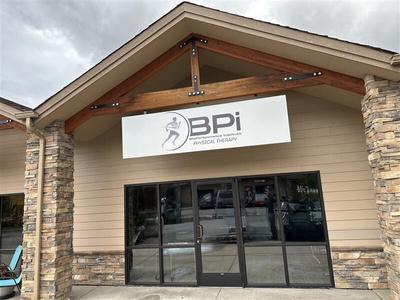










While I’m not a great gardener myself, my next-door neighbors have amazing green thumbs. This means I get to benefit from all their hard work from spring through fall and enjoy the beautiful colors and scents of the flowers they grow and observe the pollinators they attract.
One way to improve my gardening skills at the library is with their full slate of programs this spring that are presented by WSU Extension Spokane County Master Gardener Volunteers and other local experts to help budding and experienced gardeners alike.
The gardening program I’m most looking forward to is “No-Dig
Expo ’74 was the first World’s Fair that was environmentally themed, and it changed Spokane’s landscape permanently. Riverfront Park’s old railroad lines and trestles were replaced with the IMAX theater (new technology at the time), butterfly sculptures (including the remaining one), the Looff Carrousel, and the Spokane Convention Center (Washington State Pavilion at the time of the fair).
Spokanites and those visiting Spokane crowded around exhibits from Kodak and General Motors and listened to a mid-Watergate address from the controversial President Richard Nixon. Innovators and scientists discussed concerns about
Gardening.” With this method of gardening, you put compost (yay, composting!) on top of the soil and plant in the compost itself. That means you don’t have to dig rows into the soil for the seeds you’re planting, so your back gets a rest. During this program, professional gardener Erin Nelson discusses no-dig techniques that work for raised beds, field planting, and even container gardens.
“No-Dig Gardening” is taking place at Otis Orchards Library (22324 E Wellesley Ave) on Tuesday, April 23, at 6:30pm, and at Spokane Valley Library (22 N Herald Rd) on Thursday, April 25, at 6:30pm.
If you’re curious about what it takes to start home composting, be sure to drop in for the “Composting 101” program at Otis Orchards Library on Wednesday, May 8, at 6:30pm. Mark Cuilla, Spokane County Master Composter/Recycler, walks us through composting basics, including how to troubleshoot your compost pile.
With our unpredictable spring weather, one option to get a jump on the growing season is to plant seeds
the effects of deforestation, nuclear waste, and greenhouse effects— issues that have continued to inspire discussions about climate change and environmental stewardship for 50 years.
In celebration of the 50th anniversary, Spokane County Library District (SCLD) invites you to drop off memorabilia and photos from Expo ’74 at any of our library locations for an exhibit we’re sharing in July. You can also submit images online at www.scld.org/expo-74.
If you have Expo ’74 stories and memories to share, then the library would like to video record and share them online as well. Simply indicate your interest on the form in our libraries or online at the link above.
Items for the exhibit are being collected April 1–May 10. You can enjoy a showcase of World’s Fair items exhibited at Otis Orchards Library (22324 E Wellesley Ave) in July. Items dropped off at Spokane Valley and Argonne Libraries, neither of which have display cases, will be viewable online and distributed to exhibits at other libraries.
For the celebration, we’ve also partnered with the League of Women
indoors. I remember my mom planting tomato seeds in small containers in March and setting them up under a grow light on an unused kitchen counter. Then, after they germinated and sprouted, she had sturdy starters to plant outside when spring had truly arrived.
If you have extra starters to share and would like to add some variety to your own garden, swing by the “Starter Plants Swap” to share yours and see what’s available from others at Spokane Valley Library on Saturday, May 25, from 1pm to 4pm.
Also, our seed libraries at Spokane Valley and Otis Orchards Libraries let you borrow vegetable, flower, and herb seeds to plant in your garden. At harvest time, you collect some of your heirloom (non-hybrid) seeds and bring them back to the library for other gardeners to enjoy. Learn more at www.scld.org/seed-libraries.
We also have many inspirational and informational print and digital books about gardening. Stop by the library to get help from our staff to find the books you need for your next garden project.
Voters to provide opportunities for civic discussion about the focus of Expo ’74—the environment. During the program “Expo ’74: 50 Years of Environmental Awareness,” we discuss how individuals, neighborhoods, and municipalities can take action to prepare for the impacts of the climate crisis. You can share your concerns, ask questions, and exchange ideas with others.
These discussions take place at Spokane Valley Library (22 N Herald Rd) on Wednesday May 8, at 6:30pm, and at Argonne Library (4322 N Argonne Rd) on Thursday, June 6, at 4pm.
If you’re interested in learning more about these topics before the talks, you can check out titles from our climate booklist at www.scld. org/climate-booklist. For local information on climate-related topics, head to our Civic Lab Online at www.scld.org/civiclab-online. There you’ll find facts about Spokane’s Recycling, Water Conservation and Gardening, and Nuclear Waste and Power.
We look forward to sharing your Expo ’74 memories and hearing your thoughts about the current climate crisis.
April 3, 2024
Give the gift of reading.
Your donation helps provide books for 1,000+ kids and teens this summer.
Scan the code
Or visit
www.supportscld.org/lgd
ALL SCLD LIBRARIES
April 7–13
Bring in your nonperishable food items to help those facing food insecurity.
Your food donation may reduce past overdue fees on your account. Stop by your library to learn more.



(509) 994-1599
• Estate Planning
• Probate and Trust Administration
• Long-Term Care Planning
• Free Initial Consultation
• www.tate-lawoffices.com
23403 E Mission Ave, Suite 103, Liberty Lake, WA 99019
A pair of Spokane Valley Hearing Examiner decisions has opened the door to turning the vacant Painted Hills Golf Course into a 584-unit planned residential development along South Dishman-Mica Road.
After three days of hearings, Jan. 31 – Feb. 2, Hearing Examiner Andrew L. Kottkamp issued rulings on March 19 approving Black Realty, Inc.’s subdivision application for the nearly 100-acre property bordered by DishmanMica on the west, Thorpe Road to the south, Madison Road to the east and residences and the Carmel of the Holy Trinity Convent on the north.
the close of business on April 13 to appeal the hearing examiner’s subdivision decision to Spokane County Superior Court.
Handling 100- and 500-year floods
Overall, 195 specific conditions were imposed by Kottkamp on the subdivision application. While many of these are boilerplate conditions requiring conformity to manufacturing and design standards along with local codes and utility requirements, perhaps a quarter of the conditions deal with controlling flooding in the development and to surrounding residences.
According to information from the rulings, the Painted Hills Development is located in a floodplain that receives water from the south via Chester Creek Golf Course Overflow and the northeast from an unnamed tributary of the creek. In order to proceed with development, Black Realty proposes to revise the floodplain boundaries and the Federal Emergency Management Agency’s (FEMA) Flood Insurance Rate Maps that were effective as of July 6, 2010.


Also on March 19, Kottkamp denied an appeal of the city of Spokane Valley’s Final Environmental Impact Statement for the project by the citizen’s group Painted Hills Preservation Association. The group formed soon after the property was purchased from a bank by Black Realty in 2013 for $1.1 million, and has sought to change or halt the project on a number of issues ranging from flood control to traffic impacts to nature views.
Kottkamp’s decisions are the first step in the actual process towards construction.
“This project is a private development with a quasi-judicial process heard by a hearing examiner,” Spokane Valley Communications Manage Jill Smith said after speaking with the city’s project planning team. “The hearing examiner makes the decision on subdivisions and planned residential development per the city code. This would not go to (City) Council as the decision is made by the hearing examiner, subject to appeal to the superior court.”
Project opponents have until
The developer proposes two steps to achieve this. The first is raising the level of the development by importing and grading 377,000 cubic yards of fill.
According to J.D. Power, commercial heavy-duty dump trucks haul between 10 – 16 cubic yards of fill per load, depending on the material. This would mean hauling fill to the Painted Hills project could require 23,563 to 37,700 truckloads — a process that could take several years.
The second step is building a flood-control system consisting of infiltration ponds, culverts, concretelined channel to a pipe system and filtration basins designed to handle up to 100-year flood levels as well as off-site work including replacing a ditch with a 36-inch diameter pipe, deepening of a triangular pond and installing 18 drywells in the pond bottom. Additionally, a 30-foot long, 3-foot deep box culvert under Thorpe Road and a pair of 48-inch diameter pipes extending 2,100 feet along Madison Road will be installed capable of handling 500year flood levels.
Once these are in place and
appropriate agency inspections done, the developer will file for a Letter of Map Revision from FEMA. If the letter is approved, the developer will then file that letter with the city prior to revising the Flood Insurance Rate Map.
Black Realty is also required to form a flood control district, separate from a homeowners association, to manage the flood control system. The district would employ a professional flood control engineer, and be required to maintain an operations and maintenance manual that includes emergency response measures.
The hearing examiner also implemented conditions dealing with traffic impacts from the project, during construction and afterwards. Instead of access to the project on all three roads, the examiner limited this to one access off Dishman-Mica and four off Madison Road. The Dishman-Mica access can include up to two commercial driveways, the northern most accessing a planned 228-unit multifamily complex — restricted to a right-in/ right-out configuration — while the southern driveway would allow access to the residential portion of the project. Prior to beginning of project grading, Black Realty will install a two-way left turn lane and a right-turn northbound lane on Dishman-Mica at the new proposed entrance.
For the actual project, a southbound left-turn lane shall be constructed on Dishman-Mica for the new access and the intersection with Thorpe Road. Both shall provide a minimum of 150 feet of vehicle queue storage.
On Madison, a new flashing beacon and crosswalk will be installed at the intersection of East 40th Avenue and South Madison/ South Pines to facilitate crossing of students attending nearby Horizon Middle School and Chester Elementary School further up the road. Thorpe and Madison are to be reconstructed, and a 6-foot-wide pedestrian walkway built along all three roads along the development’s perimeter.
A original traffic impact analysis done is to be upgraded. That study identified improvements to
other streets the city felt needed to handle increased traffic from the development — and Kottkamp agreed.
Improvements to the 32nd Avenue and Pines Road intersection will consist of installation of a northbound right-turn lane on Pines prior to issuing a certificate of occupancy for the project’s 400th unit. Additional traffic capacity is also expected at the intersection of 16th Avenue and Pines Road/ State Route 27, requiring a new southbound right-turn only lane on Pines and a new traffic signal at 16th and Pines, which will need to be complete before a certificate of occupancy will be issued for the 200th unit.
Lower density vs. costs and goals
Upon build out, the Painted Hills Development is projected to consist of 304 single-family units made up of 252 single-family homes of various sizes and 52 cottage or townhouse style dwellings. Besides the multifamily complex, there will also be 52 mixed-use units, 22,400 square feet of commercial development space and 29.87-acres of open space.
An existing commercial development — a restaurant — located on the southwest corner of the property is allowed to remain.
Black Realty proposed two alternatives for the project to address the flood-control issue in different ways. Alternate 2A is the system described above, while Alternate 2B removes the cottagestyle residences at the northern end of the site to allow increasing the size of one of the infiltration ponds, along with utilizing the system in 2A.
In testimony to the hearing examiner to support their appeal, opponents to the development produced “expert witnesses” to address the flood control measures. Retired homebuilder and area resident Frank Cobb estimated the cost to build the flood control system at $5 million and $7 million to import the needed fill material.
Former Spokane County assistant planning director and Kootenai County Planning Director Jim Stravens presented the option for a “low-impact subdivision” of just 205 single-family residences, an
option he said would provide lower environmental impacts, less traffic, better aesthetics and more open spaces.
Kottkamp ruled Cobb’s comments “not credible” as an expert witness because he “failed to provide an adequate foundation and basis for his opinions.” As for the low-impact subdivision alternative, Kottkamp ruled it failed to meet legal principals because it failed to provide an alternative “that would meet the development goals and objectives of the applicant” and was also not proposed by Black Realty.
Black Realty’s goal is to provide up to 600 units of housing in Spokane Valley, something the 205 homes of the low-impact subdivision would fall short of. Also, selling fewer homes would not cover the construction costs needed for implementing the low-impact proposal, which the applicant’s engineer Todd Whipple told Kottkamp would be 60% of Cobb’s $12 million estimate for fill and flood control.
Based upon this and other testimony, Kottkamp denied the appeal and affirmed the city’s Final Environmental Impact Statement.
Next steps
The hearing examiner’s decisions kicks off a number of steps in the flow chart that culminate with construction. Black Reality must implement the outlined flood control measures, including creation of a flood control district, and make any revisions deemed necessary.
Once those are done, FEMA’s review is conducted and a Conditional Letter of Map Revision issued. Concurrently with this, available water and sewer certificates are obtained, Phase 1 designs are submitted and an HOA is created.
Permits are then issued from Spokane Valley and Spokane County to begin grading and floodplain developments in order to construct the flood control system and other onsite improvements. Additional floodplain map forms are filed and FEMA reviews and issues its final Letter of Map Revision.
The project’s phasing plan and final plat are reviewed and if approved, building permits are issued.




The Current is committed to serving the Greater Spokane Valley area through excellent community journalism. We can’t do it at all without you, our readers, and we can’t do it for long without support from our advertisers. Please thank our business partners and look to them when offering your patronage.
Our sincere appreciation to the following businesses for their foundational partnerships withThe Current and its partner publications:

Of note: This thank you message was produced by The Current’s advertising team, which works its tail off on behalf of partner businesses, helping them share their messages through advertisements. This is an independent function from The Current’s editorial team, which has its own evaluation process to determine the community news stories and features it pursues. For more information about a win-win partnership that expertly markets your business to thousands of readers (while making this home-grown community newspaper possible), email advertise@valleycurrent.com. With story ideas, contact editor@valleycurrent.com.





Patrol dealing with at the time. It goes a long way towards a child being able to process whatever trauma they might have just been exposed to. So, it's a huge opportunity for our officers to connect with children and help them get to a better place.” The stuffed Chase and Skye will be distributed to squad cars for officers to hand out when needed.
On Monday, March 25, at the Spokane Valley Police Precinct, the Spokane Valley Kiwanis presented 1,000 stuffed PAW Patrol animals to the first responders in the Spokane Valley community. The Spokane Valley Kiwanis Club, which was chartered in 1975 and provides numerous programs to the local community, started the First Responder stuffed animal donation in 2023 and has now had its second successful event.
Last year, 300 stuffed animals were donated to the Spokane Valley Fire Department and the Spokane Valley Police Department, which were handed out to children within four weeks.
This year, the Spokane Valley Kiwanis Club continued its partnership with local businesses and community donors to raise over $8,000. “We are so thankful for our partners and major contributors who help expand the effort, which includes Modern Drywall, Blake Bledsoe Family, Idaho Central Credit Union (ICCU), Boeing Employee’s Credit Union (BECU), and the individual members of the Spokane Valley Kiwanis Club,” said Spokane Valley Kiwanis Club President Ben Wick.
Wick is in his second year as President of the club and helped start the program. “As Kiwanis, we're always about trying to make the best impact on kids for our community. My daughter had the idea of saying ‘Hey, why don't we help the police department and fire department and do some stuffed animals for kids,’ and my son was actually watching Paw Patrol on the TV that day. So it's like, well, why don't we get some PAW Patrol stuffed animals.”
Spokane Valley Police Chief David Ellis said “It help officers connect with children, get their mind maybe a little off of the tragedy that they might be
The calls officers respond to when children are involved can range from “domestic violence situations where, you know, mom and dad have just been involved in a physical altercation and one of them might end up being arrested” to “a car crash where their car is being towed and they’re just sitting on the side of the road for a while,” Chief Ellis explained.
All the Marshall stuffed animals and half of the Skye stuffed animals will be donated to the SVFD. Spokane Valley Fire Chief Frank Soto sees the primary need for the stuffed animals as comfort. “When we go on scenes, sometimes all it takes is just comforting. Sometimes we don't need to put a band-aid on, sometimes we don't need to do CPR.” He explained that, “with children it's a little bit different because they're scared. They're small and sometimes they can't tell you what's wrong. So being

able to give them this stuffed animal, this comfort creature, it's only going to help relieve their anxiety, their fear.”
Wick said that in addition to providing instant comfort, they also help ease the feeling of hesitation children might have in the future towards first responders. “We're trying to help the kids out in the community but also trying to help the police department. When you're having a really bad day, you associate them with negative connotations versus if we were to have a stuffed animal or something to help them be seen in a positive light.”
The Kiwanis Club hosts other charitable programs and events throughout the year and is always looking for new members. “You can email the Spokane Valley Kiwanis Club at president@ SpokaneValleyKiwanis.org or you can go to SpokaneValleyKiwanis. org and visit our website. If anybody wants to get involved with this or in any part of our mission of serving children, we're doing playground projects, Millwood Meals and Impact there, and more. We meet every Tuesday, and anyone is welcome to join us!”
